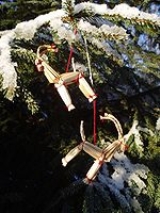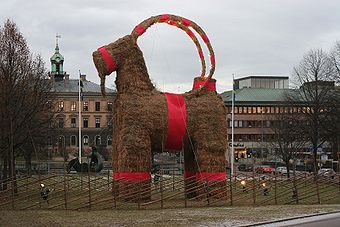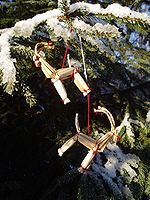
Yule Goat
Encyclopedia

Scandinavia
Scandinavia is a cultural, historical and ethno-linguistic region in northern Europe that includes the three kingdoms of Denmark, Norway and Sweden, characterized by their common ethno-cultural heritage and language. Modern Norway and Sweden proper are situated on the Scandinavian Peninsula,...
n and Northern Europe
Europe
Europe is, by convention, one of the world's seven continents. Comprising the westernmost peninsula of Eurasia, Europe is generally 'divided' from Asia to its east by the watershed divides of the Ural and Caucasus Mountains, the Ural River, the Caspian and Black Seas, and the waterways connecting...
an Yule
Yule
Yule or Yuletide is a winter festival that was initially celebrated by the historical Germanic people as a pagan religious festival, though it was later absorbed into, and equated with, the Christian festival of Christmas. The festival was originally celebrated from late December to early January...
and Christmas
Christmas
Christmas or Christmas Day is an annual holiday generally celebrated on December 25 by billions of people around the world. It is a Christian feast that commemorates the birth of Jesus Christ, liturgically closing the Advent season and initiating the season of Christmastide, which lasts twelve days...
symbols and traditions. Originally denoting the goat that was slaughtered during the Germanic pagan
Germanic paganism
Germanic paganism refers to the theology and religious practices of the Germanic peoples of north-western Europe from the Iron Age until their Christianization during the Medieval period...
festival of Yule, "Yule Goat" now typically refers to a goat-figure made of straw. It is also associated with the custom of wassailing
Wassailing
The tradition of Wassailing falls into two distinct categories: The House-Visiting wassail and the Orchard-Visiting wassail. House-Visiting wassail, very much similar to caroling, is the practice of people going door-to-door singing Christmas carols...
, sometimes referred to as "going Yule Goat" in Scandinavia.
History

Goat
The domestic goat is a subspecies of goat domesticated from the wild goat of southwest Asia and Eastern Europe. The goat is a member of the Bovidae family and is closely related to the sheep as both are in the goat-antelope subfamily Caprinae. There are over three hundred distinct breeds of...
s were connected to the Norse god Thor
Thor
In Norse mythology, Thor is a hammer-wielding god associated with thunder, lightning, storms, oak trees, strength, the protection of mankind, and also hallowing, healing, and fertility...
, who rode the sky in a chariot drawn by two goats, Tanngrisnir and Tanngnjóstr
Tanngrisnir and Tanngnjóstr
Tanngrisnir and Tanngnjóstr are the goats who pull the god Thor's chariot in Norse mythology...
, and carried his hammer Mjöllnir. The "Prose Edda
Prose Edda
The Prose Edda, also known as the Younger Edda, Snorri's Edda or simply Edda, is an Icelandic collection of four sections interspersed with excerpts from earlier skaldic and Eddic poetry containing tales from Nordic mythology...
", written by Snorri Sturluson
Snorri Sturluson
Snorri Sturluson was an Icelandic historian, poet, and politician. He was twice elected lawspeaker at the Icelandic parliament, the Althing...
in the 13th century, relates that when Thor kills and cooks the goats, their flesh provides sustenance for the god and his guests, and after Thor resurrects them with his hammer they are brought back to life the next day.
function of the Yule Goat has differed throughout the ages. In Finland
Finland
Finland , officially the Republic of Finland, is a Nordic country situated in the Fennoscandian region of Northern Europe. It is bordered by Sweden in the west, Norway in the north and Russia in the east, while Estonia lies to its south across the Gulf of Finland.Around 5.4 million people reside...
, the Yule Goat was originally said to be an ugly creature that frightened children, and demanded gifts at Christmas. In Scandinavia, people thought of the Yule Goat as an invisible creature that would appear some time before Christmas to make sure that the Yule preparations were done right. During the 19th century its role shifted towards becoming the giver of Christmas gifts, in Finland as well as the rest of Scandinavia, with one of the men in the family dressing up as the Yule Goat. The goat was replaced by jultomte or julenisse (Father Christmas
Father Christmas
Father Christmas is the name used in many English-speaking countries for a figure associated with Christmas. A similar figure with the same name exists in several other countries, including France , Spain , Brazil , Portugal , Italy , Armenia , India...
/Santa Claus
Santa Claus
Santa Claus is a folklore figure in various cultures who distributes gifts to children, normally on Christmas Eve. Each name is a variation of Saint Nicholas, but refers to Santa Claus...
) at the end of the century, although he is still called the Yule Goat (Joulupukki) in Finland, and the tradition of the man-sized goat disappeared.
A Swedish
Sweden
Sweden , officially the Kingdom of Sweden , is a Nordic country on the Scandinavian Peninsula in Northern Europe. Sweden borders with Norway and Finland and is connected to Denmark by a bridge-tunnel across the Öresund....
custom that continued up to 1940–1960 in different parts of the country, was the Yule Sacrifice (Juleoffer) involving a person dressed as a goat which, after undergoing a mock-sacrifice, is resurrected. Sir James George Frazer described its performance as follows:

- The actor, hidden by a coverlet made of skins and wearing a pair of formidable horns, is led into the room by two men, who make believe to slaughter him, while they sing verses referring to the mantles of various colours, red, blue, white, and yellow, which they laid on him, one after the other. At the conclusion of the song, the Yule Goat, after feigning death, jumps up and skips about to the amusement of the spectators.
The Yule Goat is nowadays best known as a Christmas ornament
Christmas ornament
Christmas ornaments are decorations that are used to festoon a Christmas tree.Ornaments take many different forms, from a simple round ball to highly artistic designs...
often made out of straw or roughly-hewn wood. In older Scandinavian society a popular prank was to place the Yule Goat in a neighbour's house without them noticing; the family successfully pranked had to get rid of it in the same way. The modern version of the Yule Goat figure is a decorative goat made out of straw and bound with red ribbons, a popular Christmas ornament often found under the Yule tree or Christmas tree
Christmas tree
The Christmas tree is a decorated evergreen coniferous tree, real or artificial, and a tradition associated with the celebration of Christmas. The tradition of decorating an evergreen tree at Christmas started in Livonia and Germany in the 16th century...
. Large versions of this ornament are frequently erected in towns and cities around Christmas time – these goats tend to be illegally set on fire before Christmas. The Gävle goat
Gävle goat
The Gävle Goat , located at Slottstorget in central Gävle, is a giant version of a traditional Swedish Yule Goat figure made of straw. It is erected each year over a period of two days by a local association called the Southern Merchants in time for the start of advent...
was the first of these goats, and remains the most famous.
See also
- Christmas hamChristmas hamA Christmas ham or Yule ham is a traditional ham dish associated with modern Christmas, Yule and Fennoscandian Jul. The tradition is suggested to have begun among the Germanic peoples as a tribute to Freyr, a god in Germanic Paganism associated with boars, harvest and fertility. It was later...
- Christmas treeChristmas treeThe Christmas tree is a decorated evergreen coniferous tree, real or artificial, and a tradition associated with the celebration of Christmas. The tradition of decorating an evergreen tree at Christmas started in Livonia and Germany in the 16th century...
- JulebukkingJulebukkingJulebukking is a Christmas tradition of Norwegian origin.The tradition of the Christmas buck is believed to have originated in Norway, where pagans worshiped Thor, the god who traveled in his chariot drawn by two goats. During the Yule holiday, they would disguise their appearance by dressing in a...
- JoulupukkiJoulupukkiJoulupukki is a Finnish Christmas figure. The name Joulupukki literally means Christmas Goat or Yule Goat. The Finnish word "pukki" comes from the Swedish "bock" and is an old Scandinavian tradition...
- NianNianAccording to Chinese mythology, a Nian is a beast that lives under the sea or in the mountains. Once each spring, on or around Chinese New Year, it comes out of hiding to attack people, and prefers children. Weaknesses of the Nian are purported to be a sensitivity to loud noises, and a fear of the...
- Santa ClausSanta ClausSanta Claus is a folklore figure in various cultures who distributes gifts to children, normally on Christmas Eve. Each name is a variation of Saint Nicholas, but refers to Santa Claus...
- Yule logYule logA Yule log is a large and extremely hard log which is burned in the hearth as a part of traditional Yule or Christmas celebrations in several European cultures...

